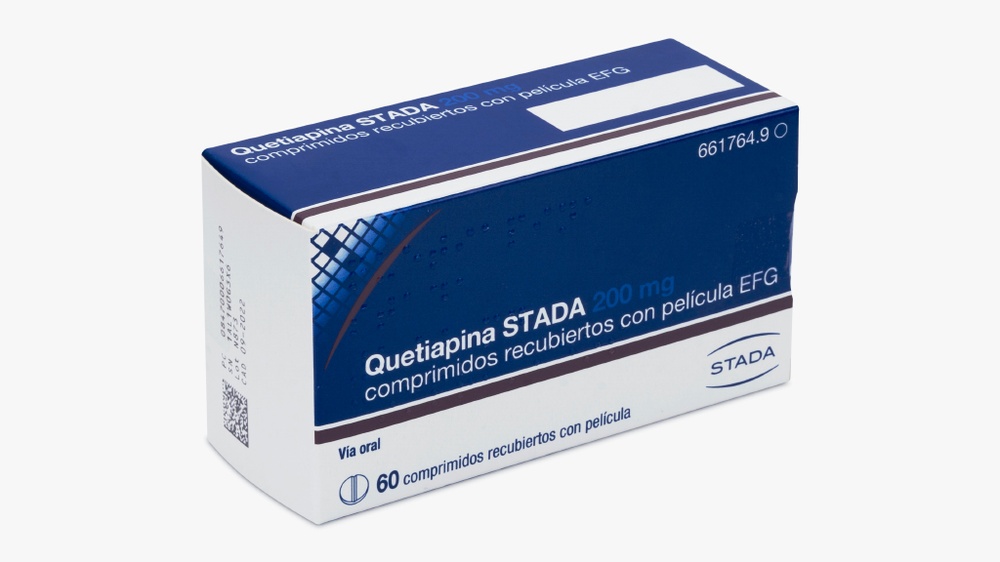

КВЕТІАПІН СТАДА 200 мг ТАБЛЕТКИ, ПОКРИТІ ПЛІВКОЮ

Запитайте лікаря про рецепт на КВЕТІАПІН СТАДА 200 мг ТАБЛЕТКИ, ПОКРИТІ ПЛІВКОЮ

Інструкція із застосування КВЕТІАПІН СТАДА 200 мг ТАБЛЕТКИ, ПОКРИТІ ПЛІВКОЮ
Вступ
Опис: інформація для пацієнта
Кветіапін STADA 200 мг покриті таблетки EFG
Кветіапін
Всією увагою прочитайте цей опис перед тим, як почати приймати цей препарат, оскільки він містить важливу інформацію для вас.
Збережіть цей опис, оскільки вам може знадобитися знову його прочитати.
Якщо у вас виникли питання, проконсультуйтеся з вашим лікарем або фармацевтом.
Цей препарат призначений тільки для вас, і не слід давати його іншим людям, навіть якщо вони мають相同ні симптоми, оскільки це може їм нашкодити.
Якщо ви відчуваєте побічні ефекти, проконсультуйтеся з вашим лікарем або фармацевтом, навіть якщо це побічні ефекти, які не вказані в цьому описі. Див. розділ 4.
Зміст опису:
- Що таке Кветіапін STADA і для чого він використовується
- Що вам потрібно знати перед тим, як почати приймати Кветіапін STADA
- Як приймати Кветіапін STADA
- Можливі побічні ефекти
- Зберігання Кветіапіну STADA
- Зміст упаковки та додаткова інформація
1. Що таке Кветіапін STADA і для чого він використовується
Кветіапін STADA містить речовину під назвою кветіапін. Він належить до групи препаратів, званих антипсихотичними. Кветіапін STADA можна використовувати для лікування різних захворювань, таких як:
- Біполярна депресія: коли ви відчуваєте смуток. Ви можете відчувати себе депресивним, відчувати провину, мати нестачу енергії, втрачати апетит або не можете спати.
- Манія: коли ви можете відчувати себе надзвичайно збудженим, ейфоричним, агітованим, ентузіастичним або гіперактивним, або мати мало судження, що включає бути агресивним або насильницьким.
- Шизофренія: коли ви можете чути або відчувати речі, які не існують, вірити в речі, які не є правдою, або відчувати себе анормально підозріливим, тривожним, плутаним, винуватим, напруженим або депресивним.
Ваш лікар може продовжувати призначати Кветіапін STADA, навіть коли ви почуваєтеся краще.
2. Що вам потрібно знати перед тим, як почати приймати Кветіапін STADA
Не приймайте Кветіапін STADA:
- якщо ви алергічні на кветіапін або на будь-який інший компонент цього препарату (включно з розділом 6).
- якщо ви приймаєте будь-який з наступних препаратів:
або деякі препарати для лікування ВІЛ
або препарати типу азол (для лікування грибкових інфекцій)
або еритроміцин або кларитроміцин (для лікування інфекцій)
або нефазодон (для лікування депресії).
Якщо у вас виникли питання, проконсультуйтеся з вашим лікарем або фармацевтом перед тим, як прийняти Кветіапін STADA.
Попередження та обережність
Проконсультуйтеся з вашим лікарем або фармацевтом перед тим, як почати приймати Кветіапін STADA:
- якщо ви, або будь-хто з вашої родини, мав або має серцеві проблеми, наприклад, проблеми з ритмом серця, слабкість серцевого м'яза або запалення серця, або якщо ви приймаєте будь-який препарат, який може впливати на серцевий ритм.
- якщо у вас низький артеріальний тиск.
- якщо ви мали інсульт, особливо якщо вам більше 65 років.
- якщо у вас є проблеми з печінкою.
- якщо ви мали епілептичний приступ (конвульсії).
- якщо ви маєте цукровий діабет або ризик його розвитку. Якщо так, ваш лікар може контролювати ваші рівні цукру в крові під час прийому кветіапіну.
- якщо ви знаєте, що мали низькі рівні лейкоцитів (які можуть бути викликані іншими препаратами).
- якщо ви старша людина з деменцією (втрата когнітивних функцій). Якщо так, не слід приймати кветіапін, оскільки група препаратів, до якої належить Кветіапін STADA, може збільшити ризик інсульту або, в деяких випадках, ризик смерті у цих людей.
- якщо ви старша людина з хворобою Паркінсона/паркінсонізмом.
- якщо ви або будь-хто з вашої родини мав тромбози, оскільки препарати цього типу можуть бути асоційовані з утворенням тромбозів.
- якщо у вас є захворювання, при якому ваша дихання переривається на короткий час під час нічного сну (апное сну) і ви приймаєте препарати, які знижують активність мозку (снодійні).
- якщо у вас є захворювання, при якому ви не можете повністю спорожнити сечовий міхур (затримка сечі), маєте збільшену простату, обструкцію в кишечнику або підвищений тиск всередині ока. ці захворювання можуть бути викликані препаратами (антихолінергічними), які впливають на роботу нервових клітин, для лікування певних медичних станів.
- якщо ви мали проблеми з алкоголем або наркотиками.
- якщо ви маєте депресію або інші захворювання, які лікуються антидепресантами. Використання цих препаратів разом з кветіапіном може викликати серотоніновий синдром, потенційно смертельну стан (див. «Інші препарати та Кветіапін STADA»).
Повідомте вашому лікареві негайно, якщо після прийому Кветіапіну STADA ви відчуваєте щось з наступного:
- Комбінація лихоманки, сильної м'язової ригідності, потовиділення або зниження рівня свідомості (розлад, званий «малюний нейролептичний синдром»). Можливо, необхідне негайне медичне лікування.
- Неконтрольовані рухи, в основному обличчя або язика.
- Головокружіння або ви відчуваєте себе надзвичайно сонним. Це може збільшити ризик випадкових травм (падінь) у пацієнтів похилого віку.
- Епілептичні приступи (конвульсії).
- Тривала і болюча ерекція (приапізм).
- Швидкі і нерегулярні серцеві удари, навіть коли ви відпочиваєте, серцебігові порушення, проблеми з диханням, біль у грудях або необумовлена втома. Ваш лікар повинен оглянути ваше серце і, якщо необхідно, направити вас до кардіолога негайно.
Ці розлади можуть бути викликані цим типом препарату.
Повідомте вашому лікареві якнайшвидше, якщо у вас:
- Лихоманка, симптоми, схожі на грип, біль у горлі, або будь-яка інша інфекція, оскільки це може бути наслідком дуже низького рівня лейкоцитів у крові і може потребувати перерви у лікуванні кветіапіном і/або додаткового лікування.
- Запор разом з тривалим абдомінальним болем, або запор, який не реагує на лікування, оскільки це може призвести до більш серйозного порушення кишківника.
Думки про самогубство і погіршення депресії
Якщо ви депресивні, іноді ви можете думати про те, щоб нашкодити собі або вчинити самогубство. Це може збільшитися на початку лікування, оскільки всі ці препарати потребують часу, щоб розпочати діяти, зазвичай близько двох тижнів, але іноді більше. Ці думки також можуть збільшитися, якщо ви раптово припините приймати свій препарат. Ви можете бути більш схильні до таких думок, якщо ви молодий дорослий. Інформація, отримана під час клінічних досліджень, показала збільшення ризику думок про самогубство і/або самогубчої поведінки у молодих дорослих віком до 25 років з депресією.
Якщо ви коли-небудь думаєте про те, щоб нашкодити собі або вчинити самогубство, негайно зверніться до вашого лікаря або до лікарні. Це може бути корисно, якщо ви попросите близького родича або друга прочитати цей опис. Ви можете попросити їх сказати вам, якщо вони думають, що ваша депресія погіршується, або якщо вони стурбовані змінами в вашій поведінці.
Збільшення ваги
Було зафіксовано збільшення ваги у пацієнтів, які приймають кветіапін. Ви і ваш лікар повинні контролювати вашу вагу регулярно.
Діти та підлітки
Кветіапін STADA не слід приймати дітям і підліткам віком до 18 років.
Використання Кветіапіну STADA з іншими препаратами
Повідомте вашому лікареві, якщо ви приймаєте, нещодавно приймали або можете приймати будь-який інший препарат.
Не приймайте Кветіапін STADA, якщо ви використовуєте будь-який з наступних препаратів:
- Деякі препарати для лікування ВІЛ.
- Препарати типу азол (для лікування грибкових інфекцій).
- Еритроміцин або кларитроміцин (для лікування інфекцій).
- Нефазодон (для лікування депресії).
Повідомте вашому лікареві, якщо ви використовуєте будь-який з наступних препаратів:
- Препарати для лікування епілепсії (наприклад, фенітойн або карбамазепін).
- Препарати для лікування високого артеріального тиску.
- Барбітурати (для лікування труднощів із сном).
- Тіоридазин або літій (інші антипсихотичні препарати).
- Препарати, які впливають на серцевий ритм, наприклад, препарати, які можуть викликати порушення електролітного балансу (низькі рівні калію або магнію), такі як діуретики (препарати для сечовиділення) або певні антибіотики (препарати для лікування інфекцій).
- Препарати, які можуть викликати запор.
- Препарати (антихолінергічні), які впливають на роботу нервових клітин, для лікування певних медичних станів.
- Антидепресанти. Ці препарати можуть взаємодіяти з кветіапіном, і ви можете відчувати симптоми, такі як неконтрольовані рухи, агітація, галюцинації, кома, надмірне потовиділення, тремор, підвищення м'язового тонусу та температура тіла вище 38 °C (серотоніновий синдром). Зверніться до вашого лікаря, якщо ви відчуваєте ці симптоми.
Перед тим, як припинити використання будь-якого з ваших препаратів, проконсультуйтеся з вашим лікарем.
Прийом Кветіапіну STADA з їжею, напоями та алкоголем
- Кветіапін STADA можна приймати з або без їжі.
- Будьте обережні з кількістю алкоголю, який ви вживаєте. Це пов'язано з тим, що комбінований ефект Кветіапіну STADA та алкоголю може викликати сонливість.
- Не приймайте грейпфрутовий сік під час прийому Кветіапіну STADA. Це може вплинути на дію препарату.
Вагітність та лактація
Якщо ви вагітні або перебуваєте в період лактації, вважаєте, що можете бути вагітною або плануєте вагітність, проконсультуйтеся з вашим лікарем перед тим, як використовувати цей препарат. Не слід приймати Кветіапін STADA під час вагітності, якщо тільки ваш лікар не порадив вам цього. Не слід використовувати Кветіапін STADA під час лактації.
Наступні симптоми, які можуть бути ознакою синдрому відміни, можуть виникнути у новонароджених дітей матерів, які приймали кветіапін у третьому триместрі (останні три місяці вагітності): тремор, м'язова ригідність і/або слабкість, сонливість, агітація, проблеми з диханням та труднощі з харчуванням. Якщо ваш новонароджений має будь-який з цих симптомів, можливо, вам потрібно буде звернутися до вашого лікаря.
Водіння транспортних засобів та використання машин
Ці таблетки можуть викликати сонливість. Не водьте транспортні засоби та не використовуйте машини, поки ви не дізнаєтеся, як вони впливають на вас.
Вплив на тести на виявлення наркотиків у сечі
Якщо вам роблять тест на виявлення наркотиків у сечі, прийом кветіапіну може давати позитивні результати для метадону або певних антидепресантів, коли використовуються деякі методи аналізу, хоча ви можете не приймати метадон або антидепресанти. Якщо це відбувається, можна провести більш специфічний тест.
Кветіапін STADA містить лактозу
Якщо ваш лікар сказав вам, що у вас є непереносимість певних цукрів, проконсультуйтеся з ним перед тим, як прийняти цей препарат.
Кветіапін STADA містить натрій
Цей препарат містить менше 1 ммоль натрію (23 мг) на таблетку; це означає, що він практично не містить натрію.
3. Як приймати Кветіапін STADA
Слідуйте точно інструкціям з прийому цього препарату, вказаним вашим лікарем. Якщо у вас виникли питання, проконсультуйтеся з вашим лікарем або фармацевтом знову. Ваш лікар визначить вашу початкову дозу. Дозу підтримання (добову дозу) буде залежати від вашого захворювання та ваших потреб, але зазвичай вона буде між 150 мг та 800 мг.
- Ви прийматимете свої таблетки один раз на добу, перед сном, або двічі на добу, залежно від вашого захворювання.
- Проглотіть свої таблетки цілими з допомогою води.
- Ви можете приймати таблетки з або без їжі.
- Не приймайте грейпфрутовий сік під час прийому Кветіапіну STADA. Це може вплинути на дію препарату.
- Не припиняйте приймати свої таблетки, навіть якщо ви почуваєтеся краще, якщо тільки ваш лікар не сказав вам цього.
Проблеми з печінкою
Якщо у вас є проблеми з печінкою, ваш лікар може змінити вашу дозу.
Люди похилого віку
Якщо вам більше 65 років, ваш лікар може змінити вашу дозу.
Використання в дітей та підлітках
Кветіапін STADA не слід приймати дітям та підліткам віком до 18 років.
Таблетку можна розділити на дві рівні частини.
Якщо ви прийняли більше Кветіапіну STADA, ніж потрібно
Якщо ви прийняли більше Кветіапіну STADA, ніж ваш лікар призначив, ви можете відчувати сонливість, головокружіння та досвідчувати аномальні серцеві удари. Зверніться негайно до вашого лікаря або до найближчої лікарні. Візьміть з собою таблетки Кветіапіну STADA.
Ви також можете зателефонувати до служби токсикологічної інформації, телефон: 915620420, вказавши препарат та кількість, прийняту.
Якщо ви забули прийняти Кветіапін STADA
Якщо ви забули прийняти одну дозу, прийміть її якнайшвидше, коли ви про це пам'ятáte. Якщо час прийому наступної дози вже близько, то чекайте до наступного прийому. Не приймайте подвійну дозу, щоб компенсувати забуту таблетку.
Якщо ви припиняєте лікування Кветіапіном STADA
Якщо ви раптово припините приймати Кветіапін STADA, ви можете відчувати безсоння, нудоту або досвідчувати головний біль, діарею, блювоту, головокружіння або раздражливість. Ваш лікар може порадити вам поступово зменшувати дозу перед припиненням лікування.
Якщо у вас є будь-які інші питання щодо використання цього препарату, проконсультуйтеся з вашим лікарем або фармацевтом.
4. Можливі побічні ефекти
Як і всі ліки, цей препарат може викликати побічні ефекти, хоча не всі люди їх відчувають.
Дуже часті: можуть впливати на більше 1 з 10 осіб
- Головокружіння (може призвести до падінь), головний біль, сухість у роті.
- Чуття сонливості (яке може зникнути з часом, коли ви продовжите приймати квтіапін), (може призвести до падінь).
- Симптоми відміни (симптоми, які виникають, коли ви припиняєте приймати квтіапін), які включають неможливість заснути (безсоння), відчуття нудоти, головний біль, діарею, блювоту, головокружіння та раздражливість. Рекомендується поступове припинення протягом періоду не менше 1-2 тижнів.
- Збільшення ваги.
- Аномальні м'язові рухи. Це включає труднощі з початком м'язових рухів, тремор, відчуття неспокою або м'язової жорсткості без болю.
- Зміни в кількості певних жирів (тригліцеридів та загального холестерину).
Часті: можуть впливати до 1 з 10 осіб
- Швидке серцебиття.
- Відчуття, ніби ваше серце б'ється сильно, швидко або з перервами.
- Запор, розлад шлунка (диспепсія).
- Відчуття слабкості.
- Набухання рук або ніг.
- Низький тиск, коли ви стоїте. Це може викликати відчуття головокружіння або оmdlіння (може призвести до падінь).
- Збільшення рівня цукру в крові.
- Замазаний зір.
- Аномальні сни та кошмари.
- Відчуття підвищеного апетиту.
- Відчуття раздражливості.
- Розлад мови та мовлення.
- Мислі про самогубство та погіршення депресії.
- Недостатність дихання.
- Блювота (головним чином у осіб похилого віку).
- Гарячка.
- Зміни в кількості тиреоїдних гормонів у крові.
- Зниження кількості певних типів клітин у крові.
- Збільшення кількості печінкових ферментів у крові.
- Збільшення кількості пролактину у крові. Збільшення пролактину можуть, в рідких випадках, призвести до наступного:
- У чоловіків та жінок - набухання молочних залоз та несподівана лактація.
- У жінок - відсутність менструації або нерегулярна менструація.
Менше часті: можуть впливати до 1 з 100 осіб
- Епілептичні напади чи конвульсії.
- Алергічні реакції, які можуть включати висипи, набухання шкіри та набухання навколо рота.
- Неприємні відчуття у ногах (також називається синдромом неспокійних ніг).
- Труднощі з ковтанням.
- Неконтрольовані рухи, головним чином обличчя чи язика.
- Сексуальна дисфункція.
- Цукровий діабет.
- Зміна електричної активності серця, яку видно на ЕКГ (подовження інтервалу QT).
- Збільшення частоти серцебиття, яке може виникнути на початку лікування та бути пов'язаним з низьким тиском та оmdlінням.
- Труднощі з сечовипусканням.
- Оmdlіння (може призвести до падінь).
- Закладення носа.
- Зниження кількості червоних кров'яних тілець у крові.
- Зниження кількості натрію у крові.
- Погіршення діабету, який існував раніше.
Рідкісні: можуть впливати до 1 з 1000 осіб
- Комбінація високої температури (гарячки), потовиділення, м'язової жорсткості, відчуття сильної сонливості чи головокружіння (стан, який називається "малюнковий нейролептичний синдром").
- Жовтушність шкіри та очей (жовтяниця).
- Запалення печінки (гепатит).
- Тривале та болісне ерекційне розширення (приапізм).
- Набухання молочних залоз та несподівана лактація (галакторея).
- Розлад менструації.
- Тромби у венах, особливо у ногах (симптоми включають набухання, біль та червоніння ноги), які можуть переміститися через кровоносні судини до легень, викликаючи біль у грудній клітці та труднощі з диханням. Якщо ви спостерігали будь-які з цих симптомів, негайно зверніться до лікаря.
- Ходіння, розмова, прийом їжі чи інші дії під час сну.
- Зниження температури тіла (гіпотермія).
- Запалення підшлункової залози.
- Стан (названий "метаболічний синдром"), при якому ви можете мати комбінацію 3 або більше з наступних ефектів: збільшення жиру навколо живота, зниження "хорошого" холестерину (HDL-C), збільшення рівня тригліцеридів у крові, збільшення тиску та збільшення рівня цукру у крові.
- Комбінація гарячки, симптомів, подібних до грипу, болю в горлі чи будь-якої іншої інфекції з низьким рівнем лейкоцитів, стан, який називається агранулоцитоз.
- Закладення кишечника.
- Збільшення рівня креатинфосфокінази у крові (речовина, яка знаходиться у м'язах).
Дуже рідкісні: можуть впливати до 1 з 10 000 осіб
- Важкий висип, пухирі чи червоні плями на шкірі.
- Важка алергічна реакція (названа анафілаксією), яка може викликати труднощі з диханням чи шок.
- Швидке набухання шкіри, зазвичай навколо очей, губ та горла (ангіоневротичний набухання).
- Важкий стан пухирів на шкірі, роті, очах та геніталіях (синдром Стівенса-Джонсона).
- Неправильна секреція гормону, який контролює об'єм сечі.
- Розрив м'язових волокон та біль у м'язах (рабдоміоліз).
Невідомі: частота не може бути оцінена з доступних даних
- Висипи на шкірі з нерівними червоними плямами (еритема мультиформе).
- Раптова та важка алергічна реакція з симптомами, такими як гарячка та пухирі на шкірі та лущення шкіри (токсична епідермальна некроліз).
- Можуть виникнути симптоми відміни у новонароджених дітей матерів, які приймали квтіапін під час вагітності.
- Лікарський висип з еозінофілією та системними симптомами (DRESS, за англійською абревіатурою). Загальний висип, підвищена температура тіла, підвищені печінкові ферменти, аномалії крові (еозінофілія), збільшені лімфатичні вузли та інші залучені органи (лікарський висип з еозінофілією та системними симптомами, який також називається DRESS). Якщо ви розвинули ці симптоми, припиніть приймати квтіапін та зверніться до лікаря або шукайте медичну допомогу негайно.
- Інсульт
- Розлад серцевого м'яза (кардіоміопатія)
- Запалення серцевого м'яза (міокардит)
- Запалення кровоносних судин (васкуліт), часто з висипом на шкірі з маленькими червоними або фіолетовими плямами.
Клас лікарських засобів, до якого належить Квтіапін STADA, може викликати проблеми з серцевим ритмом, які можуть бути важкими та в рідких випадках можуть бути смертельними.
Деякі побічні ефекти спостерігаються лише при проведенні аналізу крові. Це включає зміни в кількості певних жирів (тригліцеридів та загального холестерину) або цукру в крові, зміни в кількості тиреоїдних гормонів у крові, збільшення печінкових ферментів, зниження кількості певних типів клітин крові, зниження кількості червоних кров'яних тілець, збільшення рівня креатинфосфокінази у крові (речовина, яка знаходиться у м'язах), зниження кількості натрію у крові та збільшення рівня пролактину у крові. Збільшення пролактину можуть, в рідких випадках, призвести до наступного:
- У чоловіків та жінок - набухання молочних залоз та несподівана лактація.
- У жінок - відсутність менструації або нерегулярна менструація. Ваш лікар може попросити вас зробити аналіз крові час від часу.
Додаткові побічні ефекти у дітей та підлітків
Ті самі побічні ефекти, які можуть виникнути у дорослих, також можуть виникнути у дітей та підлітків.
Наступні побічні ефекти спостерігалися частіше у дітей та підлітків або не спостерігалися у дорослих:
Дуже часті: можуть впливати на більше 1 з 10 осіб
- Збільшення рівня гормону пролактину у крові. Збільшення пролактину можуть, в рідких випадках, призвести до наступного:
о Тато в дітей та дівчат - набухання молочних залоз та несподівана лактація.
о У дівчат - відсутність менструації або нерегулярна менструація.
- Збільшення апетиту.
- Блювота.
- Аномальні м'язові рухи. Це включає труднощі з початком м'язових рухів, тремор, відчуття неспокою або м'язової жорсткості без болю.
- Збільшення тиску.
Часті: можуть впливати до 1 з 10 осіб
- Відчуття слабкості, оmdlіння (може призвести до падінь).
- Закладення носа.
- Відчуття раздражливості.
Звіт про побічні ефекти
Якщо ви відчуваєте будь-який побічний ефект, проконсультуйтеся з лікарем або фармацевтом, навіть якщо це можливі побічні ефекти, які не вказані в цьому листку. Ви також можете повідомити про них безпосередньо через Іспанську систему фармакологічного нагляду за лікарськими засобами для людини: https//www.notificaram.es. Надсилаючи повідомлення про побічні ефекти, ви можете допомогти надати більше інформації про безпеку цього лікарського засобу.
5. Зберігання Квтіапіну STADA
Тримайте цей лікарський засіб поза зоною досяжності дітей.
Не використовуйте цей лікарський засіб після закінчення терміну придатності, який вказаний на упаковці після CAD. Термін придатності - останній день місяця, який вказаний.
Тримайте таблетки в оригінальній упаковці. Не потрібно спеціальних умов зберігання.
Лікарські засоби не повинні викидати в каналізацію чи сміття. Відкладайте упаковки та лікарські засоби, які вам не потрібні, у пункт збору фармацевтичного сміття. У разі сумнівів запитайте у фармацевта, як позбутися упаковок та лікарських засобів, які вам не потрібні. Таким чином, ви допоможете захистити довкілля.
6. Зміст упаковки та додаткова інформація
Склад Квтіапіну STADA
Активний інгредієнт - квтіапін. Таблетки містять 200 мг квтіапіну (у вигляді геміфумарату квтіапіну).
Інші компоненти:
Ядро таблетки: лактоза моногідрат (лактоза), мікрокристалічна целюлоза, повідон, карбоксиметиламідон натрію типу А (з картоплі), дібегенат гліцерину, колоїдна діоксид кремнію та стеарат магнію
Покриття таблетки: лактоза моногідрат (лактоза), гіпромелоза, діоксид титану (E171) та макрогол 4000.
Вигляд Квтіапіну STADA та вміст упаковки
Таблетки білі, двовигнуті, круглі та зрізані з однієї сторони. Вони випускаються в алюмінієвих блистерах або PVC/алюмінієвих упаковках по 60 таблеток.
Власник дозволу на продаж та відповідальний за виробництво
Власник дозволу на продаж:
Лабораторія STADA S.L. Фредерік Момпу, 5
08960 Сант Жуст Десверн (Барселона)
Іспанія
Відповідальний за виробництво:
Neuraxpharm Pharmaceuticals, S.L.
Авда. Барселона, 69
08970 Сант Жоан Деспі (Барселона)
Іспанія
Дата останньої ревізії цього листка: Червень 2024
Детальна та актуальна інформація про цей лікарський засіб доступна на сайті Іспанського агентства лікарських засобів та медичних продуктів (AEMPS) http://www.aemps.gob.es/

Скільки коштує КВЕТІАПІН СТАДА 200 мг ТАБЛЕТКИ, ПОКРИТІ ПЛІВКОЮ в Іспанії у 2025 році?
КВЕТІАПІН СТАДА 200 мг ТАБЛЕТКИ, ПОКРИТІ ПЛІВКОЮ коштує в середньому 64.82 євро у грудень, 2025 році. Ціна може змінюватися залежно від регіону, аптеки та наявності рецепта. Рекомендуємо перевіряти актуальну вартість у місцевих аптеках або через онлайн-сервіси.
- Країна реєстрації
- Середня ціна в аптеках64.82 EUR
- Діючі речовини
- Потрібен рецептТак
- Виробник
- Інформація є довідковою і не є медичною порадою. Перед прийомом будь-яких препаратів обов'язково проконсультуйтеся з лікарем. Oladoctor не несе відповідальності за медичні рішення, прийняті на основі цього контенту.
- Альтернативи до КВЕТІАПІН СТАДА 200 мг ТАБЛЕТКИ, ПОКРИТІ ПЛІВКОЮФорма випуску: ТАБЛЕТКА З МОДИФІКОВАНИМ ВИВІЛЬНЕННЯМ, 150 мгДіючі речовини: quetiapineВиробник: Accord Healthcare S.L.U.Потрібен рецептФорма випуску: ТАБЛЕТКА З МОДИФІКОВАНИМ ВИВІЛЬНЕННЯМ, 50 мгДіючі речовини: quetiapineВиробник: Accord Healthcare S.L.U.Потрібен рецептФорма випуску: ОРАЛЬНИЙ РОЗЧИН/СУСПЕНЗІЯ, 25 мг/млДіючі речовини: quetiapineВиробник: Italfarmaco S.A.Потрібен рецепт
Аналоги КВЕТІАПІН СТАДА 200 мг ТАБЛЕТКИ, ПОКРИТІ ПЛІВКОЮ в інших країнах
Найкращі аналоги з тією самою діючою речовиною та терапевтичним ефектом.
Аналог КВЕТІАПІН СТАДА 200 мг ТАБЛЕТКИ, ПОКРИТІ ПЛІВКОЮ у Польща
Аналог КВЕТІАПІН СТАДА 200 мг ТАБЛЕТКИ, ПОКРИТІ ПЛІВКОЮ у Україна
Лікарі онлайн щодо КВЕТІАПІН СТАДА 200 мг ТАБЛЕТКИ, ПОКРИТІ ПЛІВКОЮ
Консультація щодо дозування, побічних ефектів, взаємодій, протипоказань та поновлення рецепта на КВЕТІАПІН СТАДА 200 мг ТАБЛЕТКИ, ПОКРИТІ ПЛІВКОЮ – за рішенням лікаря та згідно з місцевими правилами.










